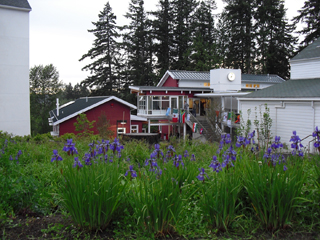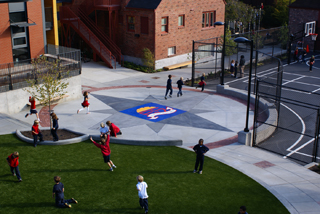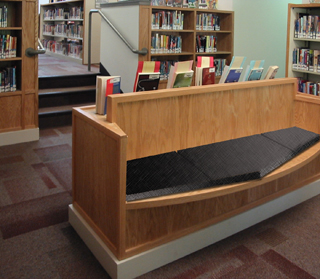|
Subscribe / Renew |
|
|
Contact Us |
|
| ► Subscribe to our Free Weekly Newsletter | |
| home | Welcome, sign in or click here to subscribe. | login |
Construction
| |
 |
August 25, 2011
What I’ve learned after 15 years of designing schools
Johnson+ Southerland

Southerland
|
Gone is the illusion of uniformly well-groomed children sitting in neat rows of desks, in rapt attention, the teacher carefully lettering the day’s assignment on a blackboard.
We’ve come to understand that each student learns differently and that students come from a wide range of homes, cultures and values. Today, a successful classroom provides a platform for the teacher to find various ways of conveying information and engaging the student.
Our past 15 years of designing public and private schools have taught us a lot about how the classroom itself can enhance the process of learning. Here are a few of my favorite “lessons learned”:
Know your client. Know your client at a variety of levels, starting with identity. Some schools have a very strong sense of identity shared by the entire community. You hear it in the mission statement and when teachers, parents and administrators talk about their school.
It permeates the academic program, and the building should express it, too. For instance, a school may pride itself in being “nurturing” or “high tech.” At a school whose mission is “creating citizens of the world,” you may find that they need a kitchen in every language classroom. A school that is a “garden of learners” may want a real garden at the center of their campus.
We conduct workshops to learn what values are most important to each school community. We interview every administrator, teacher and support staff member possible and develop program documents from a detailed inventory of their wishes, needs and capabilities.
Listening and responding results in spaces that really work. The added benefit is a community that feels real ownership of the new project.
Classroom shape. Rectangular classrooms may have a lot of advantages in terms of easy furniture layout and costs, but in some cases we’ve found that a non-traditionally shaped room works really well, particularly for the younger grades.
A room with a non-rectangular shape provides a variety of sub-spaces. The teacher can use these to break a large classroom into smaller groups of similar learning styles, provide quiet space for individuals or dedicate a space for a special project, such as an aquarium.
In addition, nonparallel walls provide the added benefit of controlling acoustic reverberation — beneficial for children with attention disorder or hearing impairment.
Rooms as backdrop. Good design is unobtrusive. Over-design ages poorly. It’s overstating it to say you want to make the classroom a neutral canvas, but you do want to design spaces that teachers can make their own.
Remember that most primary and secondary teachers want to put a lot of material on their walls — the finishes you pick will be a backdrop. Bright and complex finishes may clash with the teacher-made displays and can be a distraction to students with attention issues.
Also, teachers need some ability to “move the furniture.” Provide systems such as sliding white boards, a variety of lighting controls and flexible storage. These allow the teacher to manipulate the classroom environment rather than adjusting their teaching style to the space.
Harden the finishes. Students of any age have a lot of bottled-up energy during classroom time. When class ends, much of that energy gets released as movement and frequently ends up being absorbed by the building’s finishes.
Walls need materials that can stand years of this type of abuse and still look good. School buildings often look tired because the hallway finishes are not designed to take the impacts of students, backpacks and carts.
Protect walls, especially corners. Money spent on wall guards pays off in the look and feel of the place, especially when integrated into the overall color and finish scheme.
Choose a floor material that can be maintained and look good year after year. If you are using carpets, choose a pattern that can hide spills and does not show traffic patterns.
Refuge and prospect. Quiet nooks overlooking the classroom or playground are helpful for some kids (or any kid at one time or another) to detach from the hustle and bustle and feel safe and calm, to have a quiet conversation, or to observe while gauging when to join in again.
A bench, a “cave,” a shelter, or a beanbag chair in the corner provides a place for students to stop and take a breath or to have a one-on-one conversation with a teacher or counselor.
Teachable moments. Many architects are including displays related to sustainability in new designs, as encouraged by the LEED criteria. Involving students in operating the building, for instance opening and closing air flow louvers or simply making the “full” or “half” flush choice, takes the teaching of sustainability a step further.
Teachable moments that come from a school’s site are truly unique, such as the “boulder train” at the Open Window School in Bellevue, which demarcates a watershed divide that runs through the campus.
Epiphany School in Seattle built a beautiful sundial on the wall of their new building as well as a large compass rose in the nearby commons pavement. These features offer many opportunities for lessons in geometry, math, geography and the solar system.
Social spaces. For older kids, social life is as important to their experience as academics (they’re not going to learn much if they are unhappy)!
They require a range of social spaces, so you want to create gathering spaces for groups and study partners, “on display” spaces and places for quiet conversations. At the Overlake School in Redmond, we developed lounges and nooks inside their three new middle and high school classroom buildings, entry plazas with ample seating outside, as well as “funky” subspaces where students like to hang out — a log at the edge of the wetland or concrete seats in the woodland garden.
These spaces can be used for outdoor learning as well.
Program the site. Often, architects can spend infinite care programming and designing the building only to find out about critical site functions late in the game.
Site elements such as drop-off and pickup, accessibility, parking and play areas are critical, and the school may have been coveting a special garden or a covered play area. If left to the last minute, you’ll probably discover that these program elements take up much more room than expected!
A successful project has a landscape architect on board at the beginning and digs deep into the requirements of the outdoor spaces during the programming phase so the building and site can be designed together.
Access to the natural world. Recognize that we are creatures needing natural light, a view beyond the immediate and a connection to the larger world.
Controlled natural light in the classroom allows better color rendition, reduces eye strain and reduces energy consumption. A tranquil view of trees or sky (rather than an active playground, parking lot or entry plaza) improves brain function and allows the mind and eyes to rest for a moment before diving back into the task at hand.
An outdoor classroom space allows learning to occur in different and engaging ways.
These efforts can help lift a school project from being merely functional to being an engaging and inspiring place of learning.
Steve Southerland is a principal at Johnson+Southerland, a Seattle architecture, landscape architecture and planning firm.
Other Stories:
- It’s time for Americans to rethink the classroom
- Designing schools for tomorrow’s scientists and engineers
- New schools are shelving the old library
- Historic schools: Restore or replace?
- Boom times at Boise State
- Induction systems can cut school HVAC costs
- How technology is reshaping the way students learn
- Tacoma elementary turns to Montessori to attract students





